
about ancient nomos
Ancient Nomos Art is a museum of galleries exhibiting ancient coins and ancient mint maps. The coin gallery displays the diverse art and history of hand-crafted ancient Greek, Roman, Byzantine, Persian and Medieval coinage. The ancient mints mapping gallery features Greek, Roman, Byzantine, Asia Minor and Medieval mint city regions and territories. Visitor's are welcome to explore, study and enjoy Ancient Nomos Art.

Greek, Lycia – 390 BC
Dynast Mithrapata
From Ancient Galleries

Obverse: Forepart of a lion roaring to the right with open jaws and tongue protruding.
Reverse: Mithrapata facing left; MITHRAPATA in Lycian around, triskeles to lower right.
LEGEND SYMBOLS
Obv: Forepart of a lion roaring to the right with open jaws and tongue protruding. Rev: Head of Lycian Dynast Mithrapata facing left; MI-THRA-PATA in Lycian around, triskeles to lower right; all within an incuse square.
Ancient Lycia was a geopolitical region in Anatolia and was well populated as a Persian satrapy, but spoke mainly the Lycian language. The Lycians’ are among the earliest to attempt depictions of their rulers on coinage. According to Classical Numismatic Group, the first Lycian portraits in the later 5th century BC were innovative, but static, idealized forms lacking individual characterization. Over the next half-century, however, the style progressed significantly toward realism, culminating in the issues of the dynasts Mithrapata and Perikles in the early-mid 4th century BC. Although coin portraiture is commonly thought to be a Hellenistic invention, the first true portraits actually appeared in Lycia in the late Classical period, under the dynasts who ruled nominally as suzerains of the Persian Great King. The coins of Mithrapata came first, depicting on their reverse the profile portrait of a man with distinctive elderly features. Little is known about Mithrapata, who exercised control circa 390-370 BC, but his remarkable coin portraits, which show him on a human scale and with remarkable realism, offer a few intriguing hints. Through the relative chronology established in L. Mildenberg’s die study, one can even see the portrait become more aged as time progressed, reflecting the realism that had been captured in these issues. Unlike earlier Lycian dynasts, Mithrapata is seen not wearing the bashlyk headgear, a Persian cap worn as a symbol of satrapal power, nor does he sport any godlike attributes. Interestingly, both Mithrapata and Perikles are depicted without any sort of satrapal headgear, which was always included in earlier Lycian portraits, perhaps indicating that they had declared their independence from the Persian king. These astonishing developments in portraiture came to an abrupt end in Lycia when Maussollos of Caria invaded the region circa 360 BC. Together with Pericles, Mithrapata was the last ruler of Lycia to issue coins. After about 360 BC, the region of Lycia was taken over by the Carian dynast Mausolus, ruler of Caria and Achaemenid Empire satrap.
DOCUMENTATION
Value: Stater. Metal: AR Silver. Weight: 9.71 grams. Mint: Lycia, Anatolia. Date: circa 390-370 BC.
Attribution: Mildenberg, Mithrapata 3 (dies 2/2); Boston MFA, Greek Coins 1950 to 1963, 229 (these dies). Olçay-Mørkholm, Podalia, NC 1971, p. 5, 60 (A3/P5); Müseler VII 66–9 (same dies); Reuter 98 (same obv. die); Falghera –; SNG Copenhagen Supp. 472 var. (arrangement of letters); Sylloge Nummorum Graecorum, Ashmolean 1200 (same dies); SNG, Aulock 4237 (same dies); Photo courtesy CNG, LLC.
Legend, Documentation and Attribution
